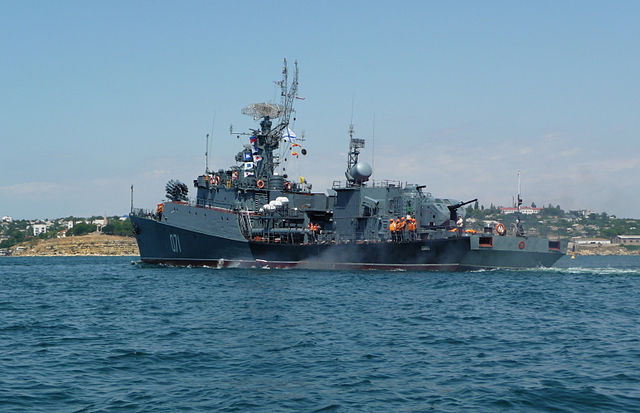
Technically, the Grisha class ships were corvettes, not Frigates which were supposed to replace the mass-built Poti class of the 1960s, and they inherited many characteristics of the previous Petya and Mirka class ASW Frigates. They were built in parallel to the large Krivak class Frigates and the first corvettes fitted with missiles as primary armament. They also relfected the upscaling in the Soviet Navy of the 1970s. Officially they were dersignated “Malyy protivolodochnyy korabl” or “Small anti-submarine ship”, acronym MPK.
Soviet designation was Project 1124 Albatros. They were dedicated anti-submarine corvettes built between 1970 and 1990. Most survived the fall of the USSR served in the Russian Federation, as well as Ukrainian Navies. Limited range had them stuck to coastal waters, fitted with upgraded ASW systems and defended by a pojnt-defence SA-N-4 ‘Gecko’ SAM. They had also retractable fin stabilizers. They were used by the Georgian and Lithuanian navies as well.
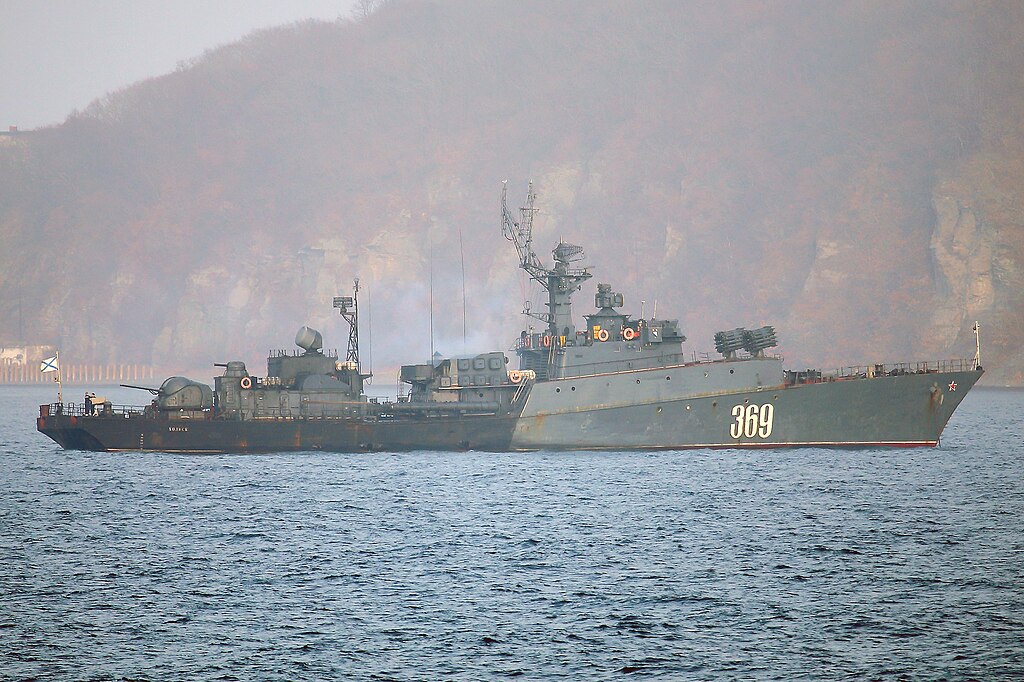 Class:
Class:
MPK-147, MPK-5, PK-131, MPK-133, MPK-33, MPK-47, MPK-65, MPK-3, MPK-8, MPK-43, MPK-40, MPK-138, MPK-141, MPK-152, MPK-161, MPK-2, MPK-49, MPK-52, MPK-31, MPK-127, MPK-6, MPK-36, MPK-41, MPK-117, MPK-81, MPK-122, MPK-143, MPK-145, MPK-170, MPK-4, MPK-101, MPK-155, MPK-37, MPK-178, MPK-191. Project 1124P (Grisha II): Brilliant, Zhemchug, Izumrud, Rubin, Almaz, Dnepr, Sapfir, Izmail, Provorny, Predanny, Nadezhny, Dozorny, Bditelny, Bezuprechny, Zorky, Reshitelny, Smely*, Bravy*, Verny*, Strogy*. Project 1124M (Grisha III): MPK-44, MPK-108, MPK-64, MPK-118, MPK-139, MPK-190, MPK-199, MPK-202, MPK-113, MPK-207, MPK-217, MPK-214, MPK-82, MPK-142, MPK-198, MPK-69, MPK-194, MPK-196, MPK-197, MPK-203, MPK-56, MPK-7, MPK-10, MPK-14, MPK-59, MPK-200, MPK-89, MPK-222, MPK-28, MPK-64, MPK-17, MPK-20*. Project 1124K (Grisha IV): MPK-104. Project 1124 MU (Grisha V): MPK-85, Ternopil. *not completed.
See also Soviet/Russian Corvettes and Frigates pages.
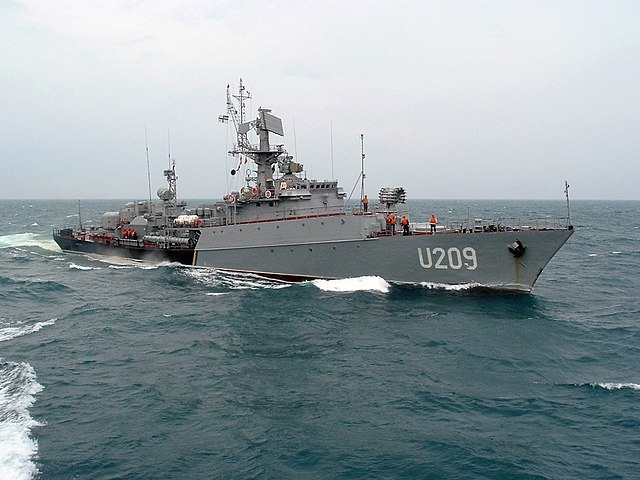
Development
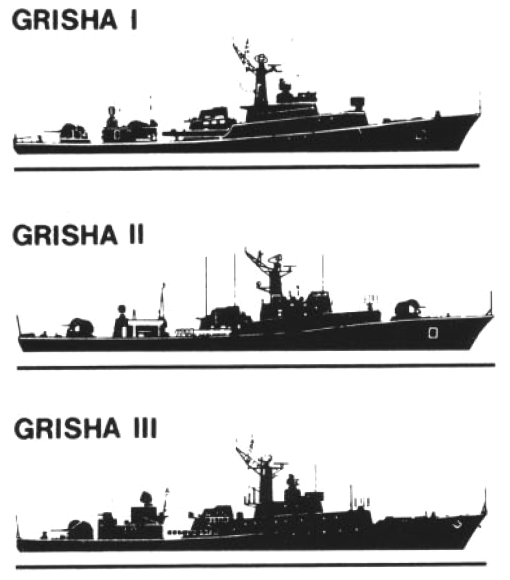
At the start of the 1960s, the Soviet fleet established the need for a new escort/anti-submarine ship of limited displacement for daily operations and replaced the 1960s generation. They were notably tasked to escort and protect Soviet SSBNs underway at depth before “dilution”, but also protect naval bases and task forces, escort coastal convoys. The fear that the new generation of submarines both with conventional and nuclear propulsion were not only faster, but had far better acoustic stealth. It was feared NATO incursions in operational zones of the Soviet Navy, including near sea zone and EEZ. They had to protect naval bases and strike formations, protect convoys in coastal areas, Baltic and Black Seas, Kola, Amur and Ussuri Bays, Avacha Bay and adjacent areas.
The Soviet Navy until then used the projects 122A and Project 122bis sub-chasers (369 built) – NATO Kronstadt class – and those of project 199 (52 units built) or MO-VI (Komar based) and those of projects 201M and 201T (183 units built, NATO SO I), as well as relatively modern vessels of project 204 (63-66 ships built, NATO Poti class). The disadvantages of the latter project included weak air defense and the insufficiently reliable AK-725 AA guns, while the experience of post-war local conflicts indicated an increasing threat to ships from aviation. Project 204 MPKs were thus outdated when in construction already, but they still had reserves for modernization which helped upgrading the design.
The Commander-in-Chief of the USSR Navy S. G. Gorshkov originally ordered to develop a new small anti-submarine ship with updated air defense and anti-submarine warfare capabilities for coastal operations, that be a development of Project 204 (Poti class). Instead of a classic AA artillery she was to be armed with a sort range self-defense missile system and for her role, a powerful towed hydroacoustic station wich both were brand new developments.
The tactical and technical assignment (TTZ) for the design was codenamed “Albatross” and issued to the Zelenodolsk design bureau (TsKB-340) in 1963, headed by Yu. A. Nikolsky as chief designer with chief observer, Central Research Institute being 2nd Rank Captain I. V. Kozlovsky. TT3 “Albatross” showed innovative solutions for the early 1960s notably for marine energy and propulsion systems under A. V. Kunakhovich and A. P. Myshakin.
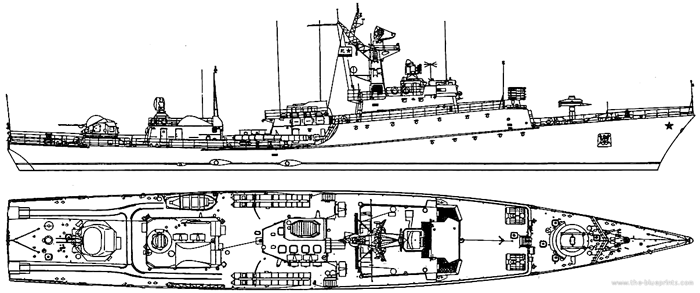
Particular attention was paid keep the displacement at 800 tons, long range at low speed with silent search, while being able to make a full speed run of at least 35 knots in attack, notably to counter recent US Navy SSNs such as the Permit and Sturgeon class. The optimal option was a combined three-shaft diesel-gas turbine power plant already proven on the projects 159 and 159A (Petya class).
Work was done also to create the most optimal hull lines, albeit limited by the strict framework to not pass the 800 tonnes mark. In order to achieve 35 knots at 800 tons, designers proposed combined hull lines with sharp-bilged and round-bilged hulls and better integrate the large under-keel fairing of the sonar, which modified the overall alignment and propulsion of the ship. The design ended with a complex shape with smoothed longitudinal ledges running along the sides to reduce splashing, later abandoned in construction to make it simpler.
The armament was formulated anf fixed, and it was to combine a circular search hydroacoustic station, Shelon type, with a transmitter antenna in the keel fairing and the new Argun VDS as well as two twin-tube 533-mm anti-submarine torpedo tubes, two rocket launchers, a twin 57-mm self-defense artillery mount.
In June 1964, the Naval Command and Ministry of Shipbuilding reviewed this draft design as Project 1124 and decided as said above to scrap the twin 57 mm and mount instead the Osa-M (4K-33) SAM, with twenty 9M-33 missiles in store, dictating to revise the internal hull volumes. Initially, it was even planned to install a retractable under-deck ZIF-122 SAM aft but the was the problem of having a fire control system nearby. It was needed also an AK-725 mount with increased firing angles, relocated at the bow, but the final version inverted these positions, SAM forward, artillery aft.
The anti-submarine armament comprised chiefly the trusted twelve-barrel RBU-6000 rocket launchers but also two twin-tube rotating 533-mm torpedo tubes, and depth charges. Comparted to the USDN ASROC it was old-fashioned, but a trusted combination helped by high speed and creeping approaches, and the new sonar suite. The under-keel and towed hydroacoustic stations were approved in their final version, for an optimal use. Thus, the technical design was completed in 1965, meeting all requirements, but at 900 tons. It was reviewed and approved by the summer of 1966 for production.
By Resolution of the Central Committee on August 10, 1964, production of Project 1124 was approved and funded, with last adjustments based on tests of the lead ship, in 1970, completed in 1972. Mass production really started in the 1970s and went on until the fall of USSR. These ships basically had to replace the Poti class.
Specialists from the Zelenodolsk Design Bureau (former TsKB-340) were awarded the USSR State Prize for their technical achievement.
Design of the class
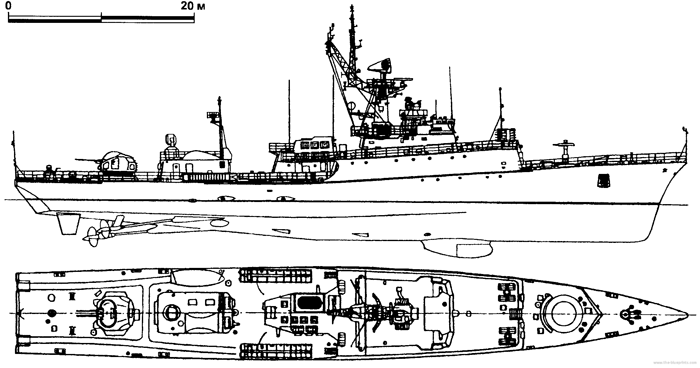
Hull and general design
The hull is flush-decked, buit in rolled steel, with a round-bilged at the bow end to achieve high speeds, sharp-bilged at the stern. The ratio is 6.8. To improve seaworthiness in heavy weather, hull had an important bow flare prolongated to the entire width, and extended sheer for the upper deck, making for a reasonably high freeboard at the bow and makign for additional internal volumes.
The hull is assembled from longitudinal framing with frame spacing beams every 500 mm. The thickness of the outer plating is 6-8 mm, with a double bottom 5 mm thick, and thicker deck flooring, platform and main bulkheads reaching 4 mm.
The main command post and vital centers are not protected, but there is an ASW partition below the waterline, with twelve compartments separated by eleven watertight bulkheads reach the weather deck. The hull has an upper and lower deck, and below a hold and the double bottom. The structures are reduced in height and compact to keep stability and metacentric height down.
Standard displacement is still 800 tons, normal displacement 850 tons, with an underwater surface of 642 m², and volume coefficient at the midship frame of 0.652, total 0.420.
The superstructures are made of aluminum-magnesium alloy AMg-5V. The forward superstructure connects to both sides, making up almost a third of the hull length with internal partitions and foundations for individual systems made of aluminum-magnesium alloys, lower the center of gravity. The double-bottom makes 90% of the hull length, used to store fresh water and fuel, pumped in and out. The Grisha class foremast is a rigid square cross-section solid aluminum-magnesium alloy pyramid. There is a small tripod mainmast forward of the separate aft superstructure made of aluminum-magnesium alloy 3-4 mm thick.
Powerplant
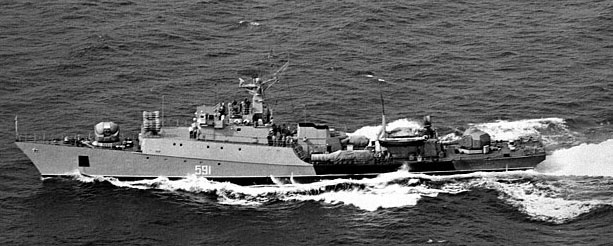
The main power plant comprises a three-shaft, echelon-type diesel-gas turbine arrangement. It is similar to the Project 159 (Petya) ships, but with a single gas turbine engine M-8M rated for 18,000 hp coming from an afterburner engine connected on the middle shaft for top speed, whereas there was a M-507A1 diesel engine rated 10,000 hp on each outer shaft for cruising.
It was installed in two compartments, forward and aft engine rooms.
In the aft ones were located the two main cruise four-stroke, reversible 112-cylinder diesel engines M-507A using gas turbine supercharging. They weighted each 17 tons. The diesels turned propellers of 2 m diameter with a 2000 hours constant use between maintenance.
Forward is located the gas turbine M-8M, with the central shaft propeller being 2.4 m wide. The turbine start-up time from cold to idle is three minutes, with full power reached after 10 minutes, including a five-minute preliminary heating stage. Service life is 10,000 hours. The gas outlet pipe is located above the forward engine room, discharged into a rectangular smoke stack.
In addition there were three diesel generators (DG-500, DG-300 and DG-200) used as APU, provide alternating three-phase current 380 V at 50 Hz for on board systems when the engines were cold.
The main diesel engines and gas turbine are controlled from the control panel via an automated remote control system.
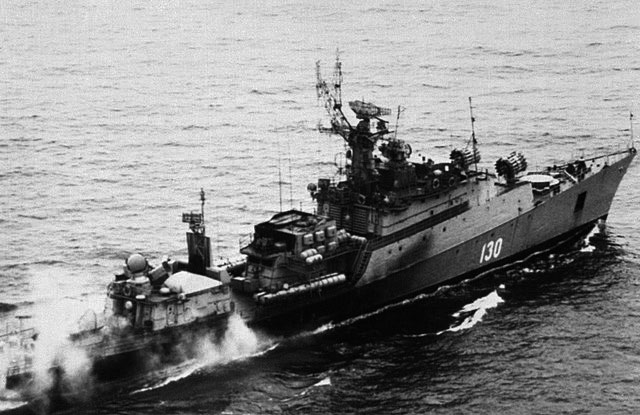
In addition there is an EK-3 electric compressor, DK-2-3 diesel compressor, auxiliary boiler unit KVA 1.0/5 M at 5 kg/cm² for other systems. There were two main distribution boards PMZh-7905-6361 and PMZh-7906-6331 plus compensators EK-2 for control. When running the diesels only, the Grisha class could reach 22 knots, the central shaft rotating freely. To reach full speed combining diesels and gas turbine was necessary, and the first ships on trials in sopme sources reached as much as 36.1 knots, and for Project 1124M ships, 32 knots. With a single diesel any Grisha class could still reach 7 knots, 16 knots with two, and 21-22 knots on the gas turbine alone, but with high consumption.
The normal fuel reserve is 134 tons, but it can be overloaded up to 143 tons with a base oil reserve of 10.5 tons, and 27.2 tons of fresh water. No ship should go below these figures for stability’s sake. Provisions were counted for 7 days of autonomy, and 9 for Project 1124M ships with a cruising range of 950 nautical miles or 1 day and 6 hours at 14 knots or 2750 nautical miles or 8 days at 10 knots up to 4000 nautical miles or 16 days at sea.
The steering uses two balanced rudders and a two-cylinder electrohydraulic steering engine R-14, with piston drive on the rudder, two variable-capacity electric pumps in the tiller compartment and an automatic steering Piton-211 system. Streamlined balance rudders are made in steel SHL-45 for 810 kg, rudder stock in forged steel, 365 kg, full rudder means 36.5° on either side.
The “axe” bow shape turned out to be unsuccessful on trials, and the Grisha clas tends to “chops” the wave, whereras in rough seas it is heavily splashed with a sharp pitching motion. The turning radius does not exceed 7 ship lengths with a heel angle of no more than 12° however, so they did not bled much speed when pushed hard rudder.
Other Equipments
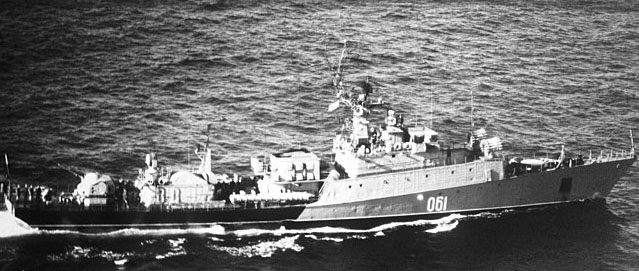
The anchor and mooring system is located in the bow with an electrohydraulic capstan ZhB or SHEG-12 type with a practical 50 m max depth. Retrieval of the chain is 23 meters per minute. The control panel is located in the wheelhouse, control post near the breakwater. Each ship has two Hall anchors 500 kg each plus two 200 meter-long high-strength anchor chains with 28 mm thick links and chain stoppers plus deck and anchor hawses, and chain lockers under the forepeak platform. Four steel cables 23.5 mm, 220 m are stored for mooring fore and aft, with six bollards, six cleats and three reels. There is also a stern mooring capstan capable of 15 meters per minute.
For port manoeuvers in the steering compartment, centerline, there is a thruster designed to keep the ship steady at sea up to 4 points, wind force 5 points and in port, turning the ship and maintaining it on course at sea state 3 with the MG-339T Shelon sonar lowered. This thruster comprises the retractable propulsion and steering column P-159M with electrohydraulic lifting drive and electromechanical propeller rotation and column rotation under the UK3K control system. To protect it when lowered, there is a a metal mesh fence. There is also a 50-liter hydraulic trim tank, electric power supply system and structural with metal grate aft. For strength reasons thius thruster is only deployed at lower speed, not above 8 knots. It is controlled remotely from the wheelhouse and backup control panel in the steering compartment. Emergency control steering comprised a manual drive. The thruster depends on main switchboards via A-3334 circuit breakers and powered by the diesel generator DSDG-500 or in parallel the two DG-200 and DG-300 diesel generators. To prevent freezing there is an heating system using piping with hot steam. The thuster could operate up to 12 times within an hour.

Rescue equipment comprised a lifeboat Yal-4 type, four inflatable life rafts PSN-10M (10 seats), ten lifebuoys and individual life jackets ISS for each crew member.
The crew of of 83 includes 9 officers, 12 warrant officers and 62 petty officers and enlisted sailors. The crew of border patrol vessels is 79, including 9 officers.
Habitability was given special attention and they all had a year-round cooling and air conditioning systems in most areas, to maintain a standard temperature, humidity, and proper air exchange aboard when every hatch and doors are closed shut, also unsuring NBC protection if needed. There is no sprinkler system to wash the bridge and deck in case of contamination however. There is a room heating and ventilation system and reuse of the steam piping plus fresh water system.
Armament
SA-N-4 Gecko SAM
Twin launcher installed forward in the hull. The Osa-M is for short range air defense, single air targets at once. It includes the retractable ZIF-122 twin-boom launcher, under the forecastle deck in a special cellar, deployed with two ready-to-launch missiles and its reloading system, twenty 9M-33 missiles in store. It depends on the 4R-33 fire control system. Rate of fire for 2 launches at air targets and 2.8 launches at surface targets, with a full reload in 16-21 s. The Osa-M SAM can engage targets at 300 m/s and 200-5000 m altitude, up to 9000 m range and 7100 m when supersonic, at low altitudes if needed between 50 and 100 m down to 4000-6000 m. The modernized Osa-MA arrived in 1979, installed on 1980s Project 1124 ships, for an an increased range of engagement or 15 kmand down to 15 m altitude
Its low rate of fire excludes combined air attacks and both aircraft and anti-ship missiles.
From 1990s it was considered obsolete and there is on board and addition set of MANPADS, one or several Strela-3 or Igla-1.
57mm/70 AK-725
Installed aft on the poop deck this twin-barreled turret 3.9 tons artillery mount AK-725 is unarmored with a weather shielding in duralumin alloy 6 mm thick, with a polyurethane foam coating on the inner surface to prevent fogging. The two 57-mm/75 ZIF-74 autocannons are located in the same cradle, with a total ammunition supply of 1,100 rounds, rate of fire of 200 rounds per minute and capable of a continuous burst of 100 rounds. The crew of two pointers, but the loading is automated, gas-operated, with an arc of fire of 200° on either sides. Firing range is 8,420 m (6,950 m with the self-destruction). There os a semi-automatic mode and lock finction with the MR-103 Bars (NATO Muff Cob) radar, Max target detection range 40 km.
Its low efficiency with non-contact fuse led to changes for Project 1124M for a single-barrel 76-mm/59 AU turret AK-176, 152 rounds. It is made of aluminum-magnesium alloy AMg-61, 4 mm thick, 2 operators, 4 in backup loading mode. 175° angles both sides, mass 10.45 tons.
30 mm AK-630M (Project 1124M/1124MU)
On the aft superstructure of the latter ships above, as well as on MPK-43 Odesskiy Komsomolets, a 30-mm AK-630M AU, six-barrelled rotating barrel is installed with belt magazine for 2,000 rounds, spare belt of 1,000 rounds stored. Usual CIWS of the Soviet/Russian navy to delete low-flying anti-ship missiles. Weightwithout ammunition 1.85 tons. Full weight 9,114 kg. Firing range 4,000 m. 4-5 bursts of 20-25 rounds, bursts of 400 rounds mx with break every 3-5 seconds.
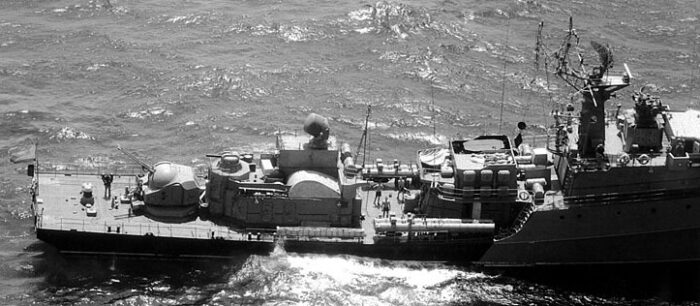
RBU-6000
At the bow on the superstructure are located a pair of 12-barrelled RBU-6000 rocket launchers. Mechanically loaded. On the 1124M (1124MU) one is removed and repolaced by a salute cannon or nothing and the left installation kept. Under the mounts the below-deck space stores 96 (1124M and 1124MU: 48) RGB-60 213 mm rocket depth charges.
Projectile weight – 119.5 kg, charge – 23.5 kg.
Loading and unloading is automatic, using a special lift, without the crew present on the upper deck.
Guidance speed, automatic mode is 30°/s, and with manual guidance 4°/s.
Automatic reload speed 3 minutes, manual mode 24 minutes.
Firing range 1.5-5.8 km.
The RGB-60 rockets has an UDV-60 impact-proximity fuse armed when hitting the water, ensuring detonation upon impact or at a pre-set depth between 15 to 350 m.
Optional acoustic non-contact fuse VB-2 with proximity up to 6 m added in the rocket. The explosion is effective withing a radius of 50 m.
The RBU receives target designation from the sonar with bearing and distance using the Burya fire control system. The RBU is electrically powered at the required angles and elevation, and settings for the rockets are transmitted vvia the same link, as well as ignition. The RBU could be used up to a sea state 8 in salvo and single shots with 0.3 s intervals to avoid interferences.
DTA-53-1124 Torpedo Tubes
The torpedo armament consists of two twin-tube banks, with a limited traverse, placed amidship behind the bow superstructure. They possesses a remote automatic traverse ATU-1 and launches via compressed air. In normal use they have a fixed angle of 27°. They could fire either following models:
Anti-ship torpedoes 53-65K
Anti-submarine torpedoes SET-53, SET-53M and SET-65.
Project 1124M ships are given the more recent KTU-77 Terek remote-controlled weapon system and could fire the TEST-3 wire guided torpedo. This electric torpedo has a range of 15-20 km, speed 25-40 knots down to 400 m max operation, and speed switch to reduce noise. Rrange 20 km for 23-25 knots. Wire lenght 20 km, homing acoustic, active-passive, two-plane, 1000 m range along the active channel. Uses a non-contact fuse by hydrolocation over a circular pattern and response radius of 10 m.
Sensors
Don-2 navigation radar:
The navigation uses the 3-cm range “Don”, maximum detection range of surface targets over 120 cables with a “dead” zone below 35 m. Ppreparation time is 5 minutes, continuous operation for 24 hours. This is completed by navigation lights and the infrared observation Khmel-III system.
There is an IFF system Nikhrom-RRM with the 082M device. The Nikhrom radar allows for identification of surface and air targets.
It is completed by a Kurs-5 gyrocompass, AP-4 automatic plotter, MGL-50 logger, NEL-5 echo sounder, 127-mm magnetic compass UKMP-3, KUS-9U, a KIV ship wind meter, ARP-50R radio direction finder, T30-21G thermal probe, Gals KPM and KPI-5F and 18 sea watches, two stopwatches, an anemometer, an SNO-T sextant, a barograph, a thermometer, a thermograph, two 75-mm magnetic boat compasses, a star globe and a set of maps.
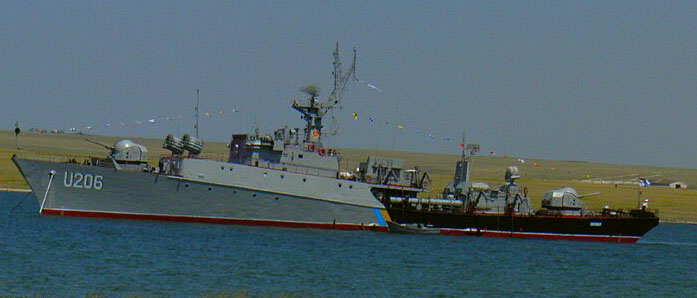
Pop Group SA-N-4 fire control radar:
The MR-302 Rubka air and surface target detection radar is used as general detection equipment, operating in the 3-10 cm radio wave range. Detection range for air targets reaches 98 km, and for surface targets 25 km. Project 1124M ships are provided the more powerful MR-320 Topaz-2V general detection radar operating in the 10-12 cm radio wave range with 100 km/40 km ranges.
The 1124M (Project 1124MU) uses the Fregat-MA-1 (MR-755) with a phased antenna array, 250 km range for general detection.
Muff Cob MR-103 fire control radar (artillery):
On Project 1124 ships, target designation for artillery systems is provided by the MR-103 Bars fire control radar system with a target detection range of 205 cables (40 km) at a target speed of up to 705 m/s. It can also be used for navigation. On late Project 1124 starting with MPC-43 “Odesskiy Komsomolets” artillery fire control for the AK-176M (AK-725) and AK-630M AU uses the more modern MR-123-02 “Vympel-221” radar control system, with a target detection range of up to 45 km without electronic interference and 30 km with.
Bull Nose low-frequency hull-mounted sonar:
The hydroacoustic suite of the Grisha class comprises at first the under-keel sonar “Argun”, operating in the echo/noise-finding modes at speeds up to 14 knots. The detection range is up to 10 km. It usus a two-stage searching cycle for submarines depending on if the ship is immobile or up to 14 knots. Generally a picket search uses first the VDS Shelon until detection, then the under-keel sonar took over and the VDS raised as the ship moves towards the inner circle until precise location, then speeds up for attack. The Shelon sonar made it possible to guide ASW aircraft to the spot as well. It was necessary to ensure frequency standards in order to eliminate mutual interference.
The 1124M ships exanged their Argun sonar for the better Platina or Platina-M, 15 km range. It could also operate in both echo and noise direction finding modes.
Elk Tail medium-frequency through-hull dipping sonar:
The lowered sonar (VDS) “Shelon”, operates only at rest, in both echo- and noise-finding modes. detection range of the Shelon sonar is within 2-50 km.
Active Protection
Bizan-4B suite with Watch Dog intercept:
To conduct electronic reconnaissance, a detector of radars type “Bizan-4B” can operate with a detection range of 28 km. The station preparation time for operation is 90s, continuous operation is max 48 hours. On ships Project 1124M ships, the “Vympel-R2” is installed.
BPK-16/Pk-10 chaff launchers
For electronic warfare (EW), Two PK-16 sixteen-barrel remote-controlled launchers are used for passive interference, firing 82 mm rockets loaded with chaff reflectors or heat traps, and four PK-10 ten-barrel launchers for passive interference, 122 mm.

Communication
Each ship is equipped with two R-654, three R-625, two T-612, T-225, two T-606, R-105, two R-680, R-676, two R-758, DKM-80, Volna-K, two NPChU, R-069, L-460.5, five POO, three VPS, PTK-3K, KMA-6, KVR, and PTK-39, P-400K and several antennas: two K-698, K-698-2, Dvoynik, two SH-10 pin antennas, three pin antennas Sh-6.
They used the “Zvezda”, “Fialka”, “082”, “067”, “KMG-12” and “6730-6S” link elements.

Author’s old illu.
⚙ specifications |
|
| Displacement | 800t standard, 980/1,070 tons FL |
| Dimensions | 71.6 x 9.8 x 3.7 m (235 ft x 32 ft x 12 ft) |
| Propulsion | 3 shaft, 2x diesels 20,000 shp, 1 gas turbine 18,000 shp |
| Speed | 34 knots (63 km/h; 39 mph) |
| Range | 4,000 nautical miles (7,400 km; 4,600 mi) at 10 knots |
| Armament | 1×2 SA-N-4 Gecko SAM, twin 57mm AK-725, 2x RBU-6000, 2×2 533 mm TTs, 2 DCR, mines |
| Active Protection | Bizan-4B suite with Watch Dog intercept |
| Sensors | Don-2 navR, Strut Curve ASR, Pop Group FCR, Muff Cob FCR, Bull Nose Sonar, Elk Tail VLS |
| Crew | 60 |
Variants
A total of 88 of the 92 ships of various series were built, including 71 Projects 1124 and 1124M (1124MU), one modified to Project 1124M, and completed as Project 1124K. Five were built in the patrol version as border patrol ships, Project P1124 and twelve more as modified border patrol ships, Project 1124P (P- stands in Russian for “border”).
Project 1124 (Grisha I)
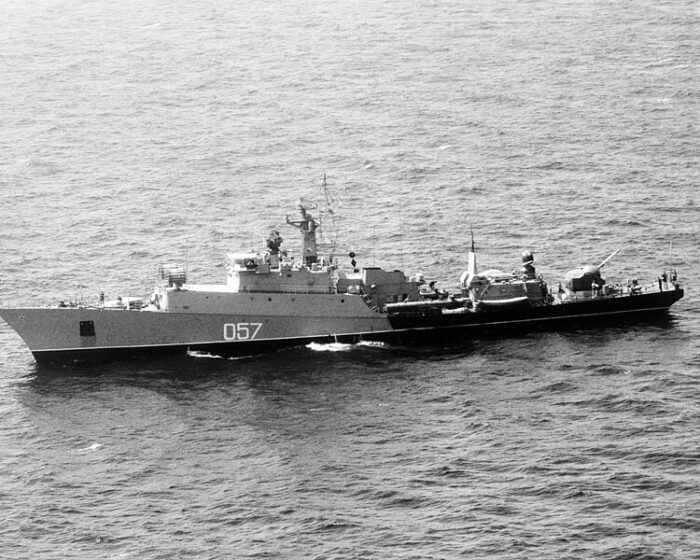
On December 26, 1966, on Krasny Metallist shipyard A. M. Gorky, Zelenodolsk (now OJSC Zelenodolsk Plant), the lead ship MPC-147 was laid down. Trials showed it was necessary to abandon the exotic “freeboard ridges” complicating manufacturing and simplify the geometry of protruding hull parts. 37 vessels of Project 1124 were ordered initially, 18 built at Zelenodolsk and 5 at the Kiev Shipyard “Leninskaya Kuznitsa” as well as 14 at the Khabarovsk Shipyard. From the 16th ship (MPK-43 “Odesskiy Komsomolets”), a 30-mm AK-630M CIWS was added, and the fire control radar RLSU MR-123 “Vympel” as well. Ships of Project 1124 under constructionhad initially no names, only numbers when entering service but received some along with patornages under the next Russian federation. As usual, numbers were completely random to confuse western observers.
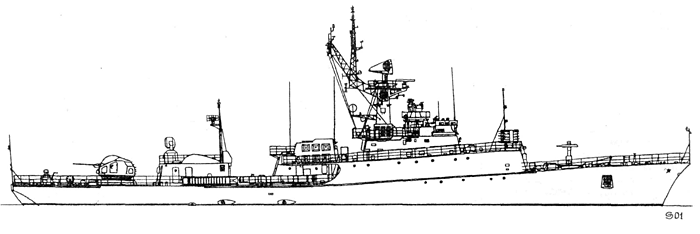
Small anti-submarine ship of project 1124 – General view

Modernized 1124 with aft CIWS AK-630
Project 1124P (Grisha II)
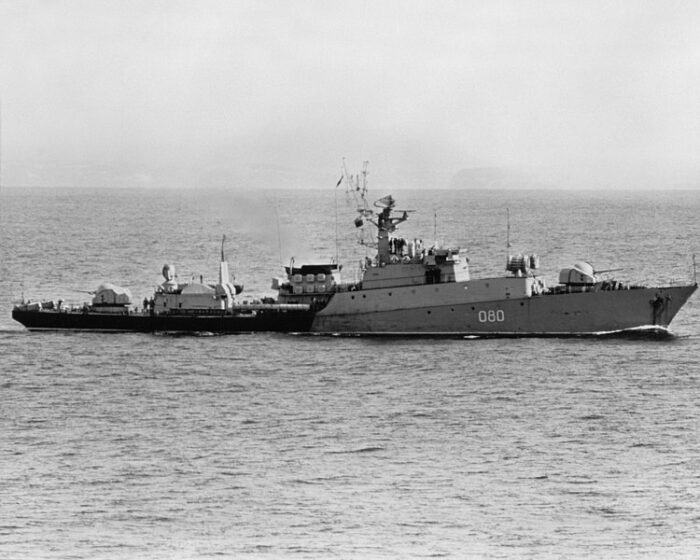
“Ametist”, Project 1124P, 1983.
The first ship was presented in 1972 at the Greater Yalta roadstead by the General Secretary L. I. Brezhnev, vacationing in Crimea as mass production of Project 1124P ships started for the KGB border guards. These border patrol ships differed by the absence of the Osa-M SAM for a second second AK-725 instead at the bow and new navigation bridge replacing the SAM fire control system. They also lacks the 30-mm AK-630M CIWS and associated MR-123 Vympel radar. The Zelenodolsk Plant built 12 of these, all with their own personal names.
Project P1124 (Grisha III)
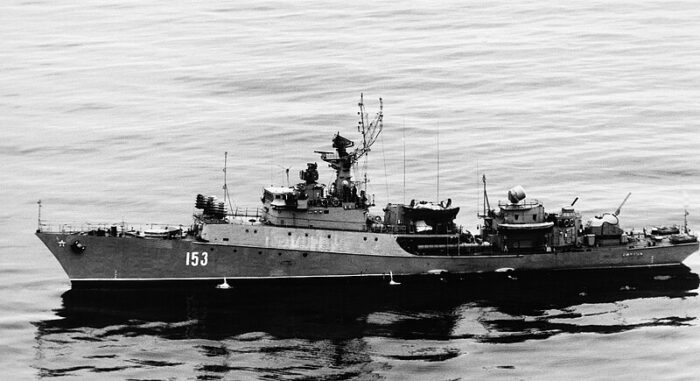
Corvette “Smely”; Project P1124. The inspection boat is installed on the left side above the torpedo tube, 1985.
In 1979-1983, the Khabarovsk Shipyard built 5 enhanced patrol ships for the Pacific Fleet and KGB borde guards. The only difference with the 1124P is that they carried an inspection boat and had a special launching and recovery device on the upper deck. Another three of these were laid down in 1988 at Vladivostok but abvandoned and scrapped latter due to the lack of funding in 1992.
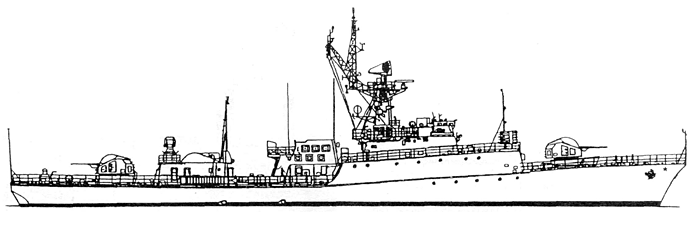
Border patrol ship of project 1124P – General view
Project 1124M (Grisha V)
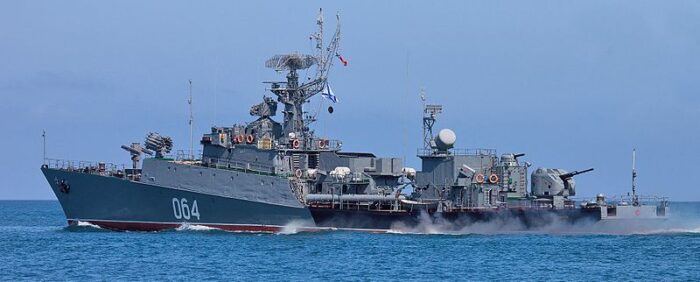
Muromets of Project 1124M (launcher of the Osa-MA SAM system in combat position); 2010.
In 1976, under Yu. A. Nikolsky and with Chief Observer Captain 2nd Rank A. P. Demeshevich, Project 1124M was started as the next evolution of the Project, yet the most radical modification comprising the new 76-mm AK-176 main gun aft, Strela-3 MANPADS and Topaz-2V general detection radar as well as the KTU-77 remote-controlled TEST-3 torpedo launcher, or KTU-71 and TEST-71. Due to the lack of free space, it was decided to abandon the right RBU launcher, and use the freed-up space to store extra systems, 1,200 kg. The overloading and increase in displacement by 30 tons overall was a detriment to seekeeping qualities with standard displacement up almost by 10%.
According to the NATO the Grisha-5 class corvettes started construction in 1982. By 1994, 31 were built, including the MU sub-version.

Small anti-submarine ship of project 1124M – General view
Project 1124K (Grisha IV)
Laid down in 1979 under Project 1124M, MPK-104 was completed under Project 1124K, an experimental ship for the Kinzhal air defense missile system. Dur to the increased weight the 76-mm AK-176 main guns, KTU-71 FCS, and Topaz-2V radar were eliminated. Whe commissioned in 1980, MPK-104 hoever still lacked its Kinzhal SAM which installation was done by late 1982. It was fully installed in 1986, and after testing operational around 1988. The ship was active in the Black Sea Fleet until 1998.
Project 1124MU
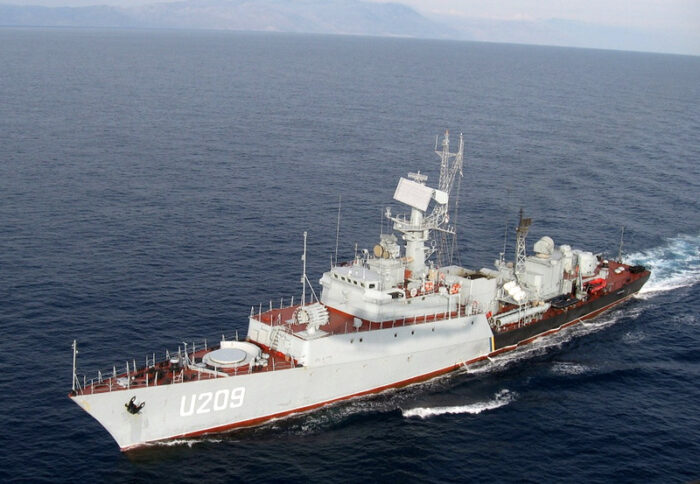
Corvette “Ternopil” (U209) of Project 1124MU of the Ukrainian Navy; 2006.
The last ships of the 1124M (Grisha V class) built since the mid-1980s were laid down under the project 1124MU, with the new general-purpose radar Fregat-MA type and Spektr-F laser warning system with 4 sensors. In 1987, MPK-69 (Zelenodolsk Shipyard), MPK-200 (Khabarovsk Shipyard) and MPK-202 (Kiev Shipyard “Leninskaya Kuznitsa”) were the first built. MPK-20 was laid down at Khabarovsk but not completed, BU in 1992.
Some of the last ships of Project 1124MU were four vessels ordered at Leninskaya Kuznitsa in 1990-1991 but after the collapse of the USSR, the Ukrainian government decided completed these, for the newly created Ukrainian Navy. Their construction was supposed to use existing stocks, equipment and weapons left over and in 1992, the first two ships were laid down at Leninskaya Kuznitsa as Lutsk and Ternopil. Both entered service in 1994 and 2006, respectively. Two more were ordered as Lviv and Zaporizhzhya Sich but were never completed due to budget cuts.
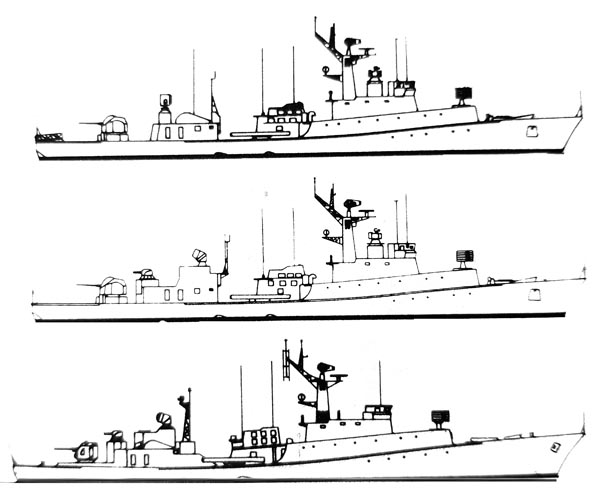
Read More/Src
Books
Apalkov Yu. V. Anti-submarine ships: [reference book]. – M.: Morkniga, 2010. – 307 p
Apalkov Yu. V. Ships of the USSR Navy: [reference book]: in 4 volumes. St. Petersburg: Galeya Print, 2005. Vol. 3.
Kostrichenko V. V. “Albatross” patrol at sea: history of ships of project 1124. – M.: Voennaya kniga, 2005
Kuzin V. P. The USSR Navy: 1945-1991: History of the creation… V. P. Kuzin; V. I. Nikolsky. St. Petersburg: Historical Marine Society, 1996.
Chuprin K. V. Armed forces of the CIS and Baltic countries: reference book/scientific editorship of A. E. Taras. Modern School, 2009.
Tested by the sea: G. S. Dmitriev. – Kazan 2009..
Conway’s All the World’s Fighting Ships, 1947-1995. Annapolis, Maryland, NIP.
Links
globalsecurity.org
russianships.info/
armyrecognition.com/ ukrainian forces sink their own corvette vinnytsia
on navypedia.org/
on naval-technology.com
globalsecurity.org/ grisha-list.htm
rg.ru/ ternopol
russianships.info/eng/today/
twz.com/ drill sinks ex ukrainian corvette
rostec.ru/en
en.wikipedia.org/ Grisha-class_corvette
on ru.wikipedia.org/
Videos
channel of Grisha class videos and footage
Model Kits
3D
Grisha class by cgpresso on Sketchfab
The Grisha class in service
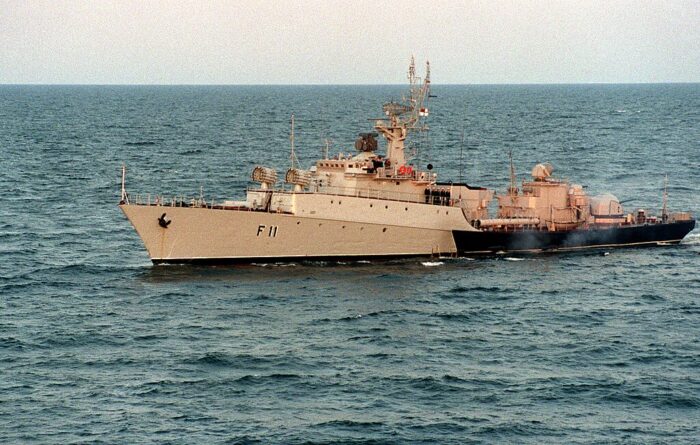
 MPK-147
MPK-147
MPK-147 (Zelenodolsk) was laid down on 26 December 1966, launched on 11 December 1967 and completed on 31 August 1970, assigned to the Black Sea. Decommissioned 19 September 1994.
 MPK-5
MPK-5
MPK-5 (Zelenodolsk) was laid down on 30 December 1967, launched on 16 October 1968, completed on 31 October 1970. Assigned to the Black Sea, Decommissioned on 24 August 1993.
 MPK-131
MPK-131
MPK-131 was laid down at Zelenodolsk on 25 May 1968, launched on 4 July 1969, completed on 30 December 1970, assigned to the Northern Fleet. Decommissioned on 31 January 1991.
 MPK-133
MPK-133
MPK-133 was laid down at Zelenodolsk on 4 October 1968, launched on 17 December 1969 and completed on 15 September 1971, Northern fleet. Decommissioned on 11 February 1994.
 MPK-33
MPK-33
MPK-33 was laid down at Zelenodolsk on 23 May 1969, launched on 30 April 1970 and completed on 24 December 1971, assigned to the Northern Fleet. She was decommissioned 7 February 1995.
 MPK-47
MPK-47
MPK-47 was laid down at Zelenodolsk on 5 September 1969, launched on 17 July 1970 and completed on 30 December 1971, assigned to the Northern fleet. She was decommissioned on 31 December 1991.
 MPK-65
MPK-65
MPK-65 was laid down at Zelenodolsk on 10 July 1970, launched on 5 February 1971 and completed on 30 September 1972, assigned to the Northern fleet. She was decommissioned on 19 April 1990.

 MPK-3
MPK-3
MPK-3 was laid down at Zelenodolsk on 12 October 1970, launched on 9 July 1971 and completed on 29 December 1972, assigned to the Northern fleet, decommissioned on 20 April 1991.
 MPK-8
MPK-8
MPK-8 was laid down at Zelenodolsk on 3 March 1971 and launched on 30 January 1972, completed on 28 September 1973, assigned to the Black Sea, and decommissioned on 3 July 1992.
 MPK-43
MPK-43
MPK-43 was laid down at Zelenodolsk on 1 August 1972, launched on 2 June 1973 and completed on 28 December 1974. She was assigned to the Black Sea Fleet and decommissioned in 1999, Renamed Odesskiy Komsomolets on 5 April 1983, Renamed MPK-43 on 15 February 1992, transferred to Ukraine and renamed Sumy on 1 August 1997.
 MPK-40
MPK-40
MPK-40 was laid down at Zelenodolsk on 28 April 1973, launched on 23 May 1974 and completed on 30 September 1975, assigned to the Northern fleet and decommissioned on 25 January 1994.
 MPK-138
MPK-138
MPK-138 was laid down at Zelenodolsk on 26 March 1975, launched on 11 May 1976 and completed on 31 December 1976, assigned to the Northern fleet and decommissioned 3 July 1992.
 MPK-141
MPK-141
MPK-141 was laid down at Zelenodolsk on 3 July 1976, launched on 16 April 1977 and completed on 30 September 1977 and assigned to the Northern fleet (Black Sea fleet until 21 September 1978) decommissioned on 5 July 1994.
 MPK-152
MPK-152
MPK-152 was laid down at Zelenodolsk on 18 November 1976, launched on 18 June 1976, completed on 30 December 1977, assigned to the Northern fleet, after the Black Sea fleet (until 21 September 1978) and decommissioned on 5 July 1994.
 MPK-161
MPK-161
MPK-161 was laid down at Zelenodolsk on 1 October 1977, launched on 6 May 1978, completed on 30 December 1978, assigned to the Baltic fleet, decommissioned on 31 July 1996.
 MPK-2
MPK-2
MPK-2 was laid down at Zelenodolsk on 10 February 1978, launched on 24 March 1979, completed on 28 November 1979, assigned to the Baltic fleet, decommissioned on 17 July 1997.
 MPK-49
MPK-49
MPK-49 was laid down at Zelenodolsk on 23 March 1980, launched on 14 February 1982 and completed on 31 August 1982 and assigned to the Black Sea (Baltic until 8 August 1984), active with the Russian Navy today as Aleksandrovets from 29 August 2004.
 MPK-52
MPK-52
MPK-52 was laid down at Kuznya on 30 October 1968, launched on 30 May 1971 and completed on 31 December 1971, assigned to the Black Sea fleet, she was decommissioned 11 June 1999. Transferred to Ukraine in the 1990s and renamed Kherson on 1 August 1997.
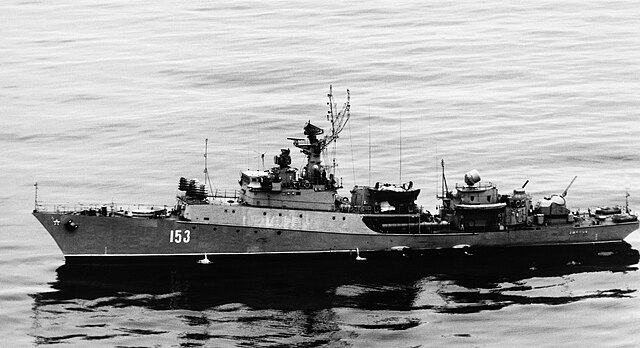
 MPK-31
MPK-31
MPK-31 was laid down at Kuznya on 30 September 1969, launched on 8 April 1973 and completed on 30 September 1973, assigned to the Northern fleet after the Black Sea fleet until 5 July 1974. She was decommissioned on 7 February 1995.
 MPK-127
MPK-127
MPK-127 was laid down at Kuznya on 16 September 1974, launched on 10 July 1976 and completed on 27 December 1976, assigned to the Black Sea fleet, decommissioned on 22 June 2005. She was renamed Komsomolets Gruzii on 26 August 1980 and MPK-127 on 15 February 1992, extant.
 MPK-127
MPK-127
MPK-127 was laid down at Kuznya on 16 September 1974, launched on 10 July 1976 and completed on 27 December 1976, assigned to the Black Sea fleet. She was decommissioned on 22 June 2005 and renamed Komsomolets Gruzii on 26 August 1980 and MPK-127 on 15 February 1992.
 MPK-6
MPK-6
MPK-6 was laid down at Kuznya on 15 July 1976, launched on 3 June 1978 and completed on 12 December 1978, assigned to the Black Sea fleet and decommissioned on 16 March 1998.
 MPK-6
MPK-6
MPK-6 was laid down at Kuznya on 15 July 1976, launched on 3 June 1978 and completed on 12 December 1978, assigned to the Black Sea fleet and decommissioned on 16 March 1998.
 MPK-36
MPK-36
MPK-36 was laid down at Khabarovsk in 1970, launched on 31 December 1972, assigned to the Pacific fleet and decommissioned on 30 June 1993.
 MPK-41
MPK-41
MPK-41 was laid down at Khabarovsk on 12 April 1971 and launched on 22 August 1972, completed on 31 December 1972 assigned to the Pacific Fleet and decommissioned on 30 June 1993.
 MPK-117
MPK-117
MPK-117 was laid down at Khabarovsk on 19 April 1972 and launched on 8 September 1973 and completed on 31 December 1973, assigned to the Pacific fleet, decommissioned on 28 February 1992.
 MPK-81
MPK-81
MPK-81 was laid down at Khabarovsk on 26 March 1973, launched on 10 August 1974 and completed on 31 December 1974, assigned to the Pacific fleet, decommissioned on 11 February 1994.
 MPK-122
MPK-122
MPK-122 was laid down at Khabarovsk on 27 April 1974, launched on 23 August 1975 and completed on 31 December 1975, assigned to the Pacific fleet and decommissioned on 5 July 1994.
MPK-143 was laid down at Khabarovsk on 25 February 1975 launched on 3 September 1976, completed on 31 December 1976, assigned to the Pacific fleet and decommissioned on 17 July 1997
 MPK-143
MPK-143
MPK-145 was laid down at Khabarovsk on 29 October 1975 launched on 11 June 1977, completed on 30 November 1977, assigned to the Pacific, decommissioned 4 August 1995
 MPK-170
MPK-170
MPK-170 was laid down at Khabarovsk on 31 May 1976 launched on 30 September 1977, completed on 14 October 1978, assigned to the Pacific, decommissioned 31 July 1996
 MPK-4
MPK-4
MPK-4 was laid down at Khabarovsk on 27 November 1976 launched on 15 May 1978, completed on 27 July 1979, assigned to the Pacific Decommissioned 17 July 1997
 MPK-101
MPK-101
MPK-101 was laid down Khabarovsk on 31 May 1977 and launched 3 October 1978, launched on 23 December 1979, assigned to the Pacific fleet, decommissioned on 16 March 1998 and renamed Zaporozhskiy Komsomolets on 3 November 1989 and MPK-101 on 15 February 1992.
 MPK-155
MPK-155
MPK-155 was laid down at Khabarovsk on 20 December 1977 launched on 29 May 1979, completed on 30 September 1980, assigned to the Pacific Decommissioned 5 July 1994
 MPK-37
MPK-37
MPK-37 was laid down at Khabarovsk launched on 31 May 1978, launched 20 October 1979, completed on 19 December 1980, assigned to the Pacific Decommissioned 4 August 1995
 MPK-178
MPK-178
MPK-178 was laid down at Khabarovsk on 30 November 1982 launched on 8 May 1984, completed on 21 December 1984, assigned to the Pacific Decommissioned in 2012 (sunk as target ship in 2013)
 MPK-191
MPK-191
MPK-191 was laid down at Khabarovsk, launched on 30 November 1982, completed on 7 May 1985, completed on 21 November 1985, assigned to the Pacific Active with Russian Navy[3] Renamed Kholmsk (1 June 2006)
Project 1124P (Grisha II)
 Brilliant
Brilliant
Brilliant was laid down at Zelenodolsk on 1 February 1972 launched on 19 October 1972, commissioned on 25 December 1973, and asigned to the Northern fleet, Decommissioned 13 March 1995.
 Zhemchug
Zhemchug
Zhemchug was laid down at Zelenodolsk on 28 March 1972 launched on 14 January 1973, completed on 30 August 1974, assigned to the Northern fleet and decommissioned 4 October 1995
 Izmurud
Izmurud
Izumrud was laid down at Zelenodolsk on 8 February 1973, launched on 3 February 1974, completed on 28 December 1974, assigned to the Northern fleet, decommissioned 2012
 Rubin
Rubin
Rubin was laid down at Zelenodolsk on 22 December 1973 launched on 17 November 1974, completed on 31 December 1975, assigned to the Northern fleet and decommissioned 15 June 1992
 Almaz
Almaz
Almaz was laid down at Zelenodolsk on 10 June 1974 launched on 12 July 1975, completed on 31 December 1975, assigned to the Northern and decommissioned 23 May 1997, renamed Ametist in September 1975.
 Dnepr
Dnepr
Dnepr was laid down at Zelenodolsk on 23 December 1975 launched on 12 September 1976, completed on 31 December 1976, assigned to the Black Sea fleet. She was decommissioned on 29 January 2021 and transferred to Ukraine in the 1990s, renamed Vinnitsa on 19 January 1996 and renamed A206 from April 2018, reported scuttled during the Russian invasion of Ukraine in 2022.
 Sapfir
Sapfir
Sapfir was laid down at Zelenodolsk on 4 May 1977, launched on 31 January 1978, completed on 31 July 1978, assigned to the Northern fleet, decommissioned on 13 June 1998.
 Izmail
Izmail
Izmail was laid down at Zelenodolsk on 12 September 1978, launched on 22 June 1980, completed on 28 December 1980, assigned to the Black Sea and decommissioned on 30 November 2004. She was transferred to Ukraine in 1990s and renamed Chernigov on 19 January 1996 and renamed Izmail on 26 July 2004.
 Provorny
Provorny
Provorny was laid down at Zelenodolsk on 21 june 1980 launched on 30 July 1982, completed on 30 December 1982, assigned to the Northern Flee and the Baltic until 1991, she was decommissioned on 4 August 1998.
 Predanny
Predanny
Predanny was laid down at Zelenodolsk on 18 March 1982 launched on 16 April 1983, completed on 30 September 1983, assigned to the Northern fleet (Baltic until 1991) and decommissioned in 2002.
 Nadezhny
Nadezhny
Nadezhny was laid down at Zelenodolsk on 19 September 1982 launched on 25 February 1984, completed on 20 September 1984, assigned to the Northern fleet and decommissioned in 2002.
 Dozorny
Dozorny
Dozorny was laid down at Zelenodolsk on 1982, launched on 1985, completed on 26 December 1985, assigned to the Northern fleet and decommissioned 2009
Bditelny was laid down at Khabarovsk on 1979 launched on 18 April 1981, completed on 25 September 1981, assigned to the Pacific fleet and decommissioned on 13 June 1998.
 Bezuprechny
Bezuprechny
Bezuprechny was laid down at Khabarovsk on 1979 launched on 1981, completed on 19 December 1981, assigned to the Pacific fleet and decommissioned in 2015.
 Zorky
Zorky
Zorky was laid down at Khabarovsk on 15 February 1980 launched on 2 November 1981, completed on 29 October 1982, assigned to the Pacific fleet and decommissioned on 20 June 2006 .
 Reshitelny
Reshitelny
Reshitelny was laid down at Khabarovsk on 28 October 1980 launched on 18 September 1982, completed on 31 August 1983, assigned to the Pacific fleet and decommissioned on 13 June 1998.
 Smely
Smely
Smely was laid down at Khabarovsk on 27 May 1981, launched on 7 April 1983, completed on 15 December 1983, assigned to the Pacific fleet and decommissioned 2015 + Bravy (Vladivostok) was laid down in 1988 as well as Verny and Strogy, not Completed.
Project 1124M (Grisha III)
 MPK-44
MPK-44
MPK-44 was laid down at Kuznya na Rybalskomu on 18 July 1977 launched on 29 March 1980, completed on 25 October 1980, assigned to the Baltic fleet, decommissioned on 22 October 2008 and renamed Komsomolets Latvii on 30 September 1983. Transferred to Lithuania and renamed MPK-44 on 15 February 1992, renamed Zemaitis on 28 April 1993, extant.
 MPK-108
MPK-108
MPK-108 was laid down at Zelenodolsk on 14 May 1979 launched on 6 February 1981, completed on 25 September 1981, assigned to the Baltic Decommissioned in April 2010 Transferred to Lithuania in 1990s
Renamed Aukstaitis (28 April 1993)
 MPK-64
MPK-64
MPK-64 was laid down at Kuznya na Rybalskomu on 30 March 1980 launched on 27 March 1982, completed on 10 December 1982, assigned to the Black Sea Active with Russian Navy[3] Renamed Kievskiy Komsomolets (27 July 1982)
Renamed MPK-134 (15 February 1992)
Renamed Muromets (5 April 1999)
 MPK-118
MPK-118
MPK-118 was laid down at Kuznya na Rybalskomu on 1 August 1981, launched on 27 March 1983, completed on 3 October 1983, assigned to the Black Sea fleet, Active with the Russian Navy and renamed Komsomolets Moldavii on 10 April 1984, MPK-118 on 15 February 1992 and Suzdalets on 5 April 1999.
 MPK-139
MPK-139
MPK-139 was laid down at Kuznya na Rybalskomu on 8 April 1982, launched on 18 February 1984, completed on 2 August 1984, assigned to the Northern Fleet, decommissioned 22 June 2005
 MPK-190
MPK-190
MPK-190 was laid down at Kuznya na Rybalskomu on 5 April 1983, launched on 20 January 1985, completed on 8 August 1985, assigned to the Northern Fleet, decommissioned 16 March 1998
 MPK-199
MPK-199
MPK-199 was laid down at Kuznya na Rybalskomu on 20 February 1984, launched on 7 December 1985, completed on 7 October 1986, assigned to the Black Sea fleet, active today with Russian Navy. Renamed Komsomolets Armenii on 18 December 1985, MPK-199 on 15 February 1992 and Kasimov in 2001.
 MPK-202
MPK-202
MPK-202 was laid down at Kuznya on 22 January 1985, launched on 10 November 1986, completed on 6 October 1987, assigned to the Northern fleet, decommissioned 16 March 1998.
 MPK-113
MPK-113
MPK-113 was laid down at Kuznya on 12 November 1985, launched on 31 July 1987, completed on 5 August 1988, assigned to the Northern fleet, decommissioned on 1 June 2001
 MPK-207
MPK-207
MPK-207 was laid down at Kuznya on 12 June 1986, launched on 6 May 1988, completed on 3 April 1989, assigned to the Black Sea, Active with Russian Navy today, renamed Povorino.
 MPK-217
MPK-217
MPK-217 was laid down at Kuznya on 16 March 1987, launched on 12 April 1989, completed on 26 December 1989, assigned to the Black Sea fleet, Active with the Russian Navy, renamed Eysk on 9 September 1999, active.
 MPK-214
MPK-214
MPK-214 was laid down at Kuznya na Rybalskomu on 20 August 1987, launched on 30 March 1990, completed on 29 September 1990, assigned to the Pacific fleet, Active with Russian Navy. She was renamed Leninskaya Kuznitsa on 2 February 1990, MPK-125 on 15 February 1992 and Sovetskaya Gavan on 12 November 2005.
 MPK-82
MPK-82
MPK-82 was laid down at Kuznya na Rybalskomu on 20 April 1989 launched on 20 April 1991, completed on 26 September 1991, assigned to the Pacific fleet and active with Russian Navy.
 MPK-142
MPK-142
MPK-142 was laid down at Zelenodolsk on 20 February 1982 launched on 19 May 1984, completed on 30 December 1984, assigned to the Northern fleet and decommissioned 16 March 1998
 MPK-198
MPK-198
MPK-198 was laid down at Zelenodolsk on 3 August 1984 launched on 27 April 1986, completed on 29 December 1986, assigned to the Northern fleet and decommissioned 16 March 1998
 MPK-69
MPK-69
MPK-69 was laid down at Zelenodolsk on 4 April 1985 launched on 2 May 1987, completed on 29 December 1987, assigned to the Northern fleet and decommissioned 16 March 1998
 MPK-194
MPK-194
MPK-194 was laid down at Zelenodolsk on 11 May 1987 launched on 30 July 1988, completed on 27 September 1988, assigned to the Northern Active with Russian Navy as Brestskiy Komsomolets (22 July 1988). Renamed MPK-194 on 15 February 1992 and Brest in July 2000
 MPK-196
MPK-196
MPK-196 was laid down at Zelenodolsk on 11 May 1987 launched on 30 July 1988, completed on 30 December 1988, assigned to the Northern fleet and decommissioned in 2002
 MPK-197
MPK-197
MPK-197 was laid down at Zelenodolsk on 27 October 1987 launched on 8 April 1989, completed on 25 October 1989, Decommissioned 3 May 2001
 MPK-203
MPK-203
MPK-203 was laid down at Zelenodolsk 26 March 1988 19 July 1989, completed on 28 December 1989, assigned to the Northern fleet, Active with Russian Navy as Yunga (2 February 1990)
 MPK-130/Arkhangelskiy Komsomolets
MPK-130/Arkhangelskiy Komsomolets
Arkhangelskiy Komsomolets was laid down at Zelenodolsk on 17 August 1988, launched on 9 March 1990, completed on 28 September 1990, assigned to the Northern Fleet, Active with Russian Navy and renamed MPK-130 on 15 February 199 and Naryan-Mar in 2002.
 MPK-56
MPK-56
MPK-56 was laid down at Zelenodolsk on 12 April 1989 launched on 30 June 1990, completed on 29 December 1990, assigned to the Northern fleet, decommissioned on 22 June 2005
 MPK-7
MPK-7
MPK-7 was laid down at Zelenodolsk on 20 April 1989 launched on 30 June 1990, completed on 28 December 1990, assigned to the Northern Active with Russian Navy[3] Renamed Onega (June 2003)
 MPK-10
MPK-10
MPK-10 was laid down at Zelenodolsk on 19 March 1990 launched on 27 July 1991, completed on 28 December 1991, assigned to the Northern fleet, decommissioned 1 June 2006
 MPK-14
MPK-14
MPK-14 was laid down at Zelenodolsk on 27 March 1991 launched on 6 June 1992, completed on 31 May 1993, assigned to the Northern fleet, Active with Russian Navy as Monchegorsk (17 August 1999)
 MPK-59
MPK-59
MPK-59 was laid down at Zelenodolsk on 20 November 1990 launched on 22 May 1993, completed on 12 August 1994, assigned to the Northern Active with Russian Navy[3] Renamed Snezhnogorsk
 MPK-200
MPK-200
MPK-200 was laid down at Khabarovsk on 8 February 1985 launched on 29 April 1987, completed on 29 December 1987, Pacific and decommissioned on 16 December 2023. Renamed Primorskiy Komsomolets on 11 August 1987 and renamed MPK-221 (15 February 1992).
 MPK-89
MPK-89
MPK-89 was laid down at Khabarovsk on 27 January 1986 launched on 3 November 1987 and completed on 13 December 1988, assigned to the Pacific and decommissioned on 17 July 1997.
 MPK-222
MPK-222
MPK-222 was laid down at Khabarovsk on 7 January 1987, launched 27 April 1989, completed on 20 December 1989, assigned to the Pacific fleet. Active with Russian Navy, renamed Koreets on 24 November 2003, active.
 MPK-28
MPK-28
MPK-28 was laid down at Khabarovsk on 2 September 1987, launched on 9 September 1989, completed on 27 December 1989 assigned to the Pacific fleet and decommissioned 22 June 2005
 MPK-107
MPK-107
Irkutskiy was laid down at Khabarovsk on 22 February 1988 launched on 5 June 1990, completed on 14 December 1990, assigned to the Pacific fleet, active with Russian Navy as MPK-107 from 15 February 1992.
 MPK-64
MPK-64
MPK-64 was laid down at Khabarovsk on 4 January 1988 launched on 2 October 1990, completed on 31 December 1990 Pacific fleet and active with Russian Navy under the name Metel from 1 October 2003.
 MPK-17
MPK-17
MPK-17 was laid down at Khabarovsk on 22 January 1990 launched on 28 August 1991, completed on 30 December 1991, assigned to the Pacific fleet and active with the Russian Navy under the name Ust-Ilimsk from 16 January 2010.
 MPK-20
MPK-20
MPK-20 was laid down at Khabarovsk on 1990, launched but not Completed.
Project 1124K (Grisha IV)
 MPK-104
MPK-104
MPK-104 was laid down at Zelenodolsk on 12 June 1979 launched on 23 March 1980 and completed on 30 October 1980, assigned to the Black Sea and decommissioned on 16 March 1998.
Project 1124 MU (Grisha V)
 MPK-85 (Lutz)
MPK-85 (Lutz)
MPK-85 was laid down at Kuznya na Rybalskomu on 11 January 1991, launched on 22 May 1993, completed on 30 December 1993, assigned to the Black Sea, Captured by Russia during the annexation of Crimea, status unknown, Completed for Ukraine and Renamed Lutsk in July 1994.
 Ternopil
Ternopil
Ternopil was laid down at Kuznya on 23 April 1991, launched on 15 March 2002 and completed on 28 December 2005, assigned to the Black Sea and captured by Russia during the annexation of Crimea Used as an exercise target for the fleet. Completed for Ukraine. Also: Lviv and Zaporozhskaya Sech (from Kuznya na Rybalskomu) were not completed.



 Latest Facebook Entry -
Latest Facebook Entry -  X(Tweeter) Naval Encyclopedia's deck archive
X(Tweeter) Naval Encyclopedia's deck archive Instagram (@navalencyc)
Instagram (@navalencyc)





 French Navy
French Navy Royal Navy
Royal Navy Russian Navy
Russian Navy Armada Espanola
Armada Espanola Austrian Navy
Austrian Navy K.u.K. Kriegsmarine
K.u.K. Kriegsmarine Dansk Marine
Dansk Marine Nautiko Hellenon
Nautiko Hellenon Koninklije Marine 1870
Koninklije Marine 1870 Marinha do Brasil
Marinha do Brasil Osmanlı Donanması
Osmanlı Donanması Marina Do Peru
Marina Do Peru Marinha do Portugal
Marinha do Portugal Regia Marina 1870
Regia Marina 1870 Nihhon Kaigun 1870
Nihhon Kaigun 1870 Preußische Marine 1870
Preußische Marine 1870 Russkiy Flot 1870
Russkiy Flot 1870 Svenska marinen
Svenska marinen Søværnet
Søværnet Union Navy
Union Navy Confederate Navy
Confederate Navy Armada de Argentina
Armada de Argentina Imperial Chinese Navy
Imperial Chinese Navy Marinha do Portugal
Marinha do Portugal Mexico
Mexico Kaiserliche Marine
Kaiserliche Marine 1898 US Navy
1898 US Navy Sovietskiy Flot
Sovietskiy Flot Royal Canadian Navy
Royal Canadian Navy Royal Australian Navy
Royal Australian Navy RNZN Fleet
RNZN Fleet Chinese Navy 1937
Chinese Navy 1937 Kriegsmarine
Kriegsmarine Chilean Navy
Chilean Navy Danish Navy
Danish Navy Finnish Navy
Finnish Navy Hellenic Navy
Hellenic Navy Polish Navy
Polish Navy Romanian Navy
Romanian Navy Turkish Navy
Turkish Navy Royal Yugoslav Navy
Royal Yugoslav Navy Royal Thai Navy
Royal Thai Navy Minor Navies
Minor Navies Albania
Albania Austria
Austria Belgium
Belgium Columbia
Columbia Costa Rica
Costa Rica Cuba
Cuba Czechoslovakia
Czechoslovakia Dominican Republic
Dominican Republic Haiti
Haiti Hungary
Hungary Honduras
Honduras Estonia
Estonia Iceland
Iceland Eire
Eire Equador
Equador Iran
Iran Iraq
Iraq Latvia
Latvia Liberia
Liberia Lithuania
Lithuania Mandchukuo
Mandchukuo Morocco
Morocco Nicaragua
Nicaragua Persia
Persia San Salvador
San Salvador Sarawak
Sarawak Uruguay
Uruguay Venezuela
Venezuela Zanzibar
Zanzibar Warsaw Pact Navies
Warsaw Pact Navies Bulgaria
Bulgaria Hungary
Hungary

 Bundesmarine
Bundesmarine Dutch Navy
Dutch Navy Hellenic Navy
Hellenic Navy Marina Militare
Marina Militare Yugoslav Navy
Yugoslav Navy Chinese Navy
Chinese Navy Indian Navy
Indian Navy Indonesian Navy
Indonesian Navy JMSDF
JMSDF North Korean Navy
North Korean Navy Pakistani Navy
Pakistani Navy Philippines Navy
Philippines Navy ROKN
ROKN Rep. of Singapore Navy
Rep. of Singapore Navy Taiwanese Navy
Taiwanese Navy IDF Navy
IDF Navy Saudi Navy
Saudi Navy Royal New Zealand Navy
Royal New Zealand Navy Egyptian Navy
Egyptian Navy South African Navy
South African Navy






























 Ukrainian Navy
Ukrainian Navy dbodesign
dbodesign